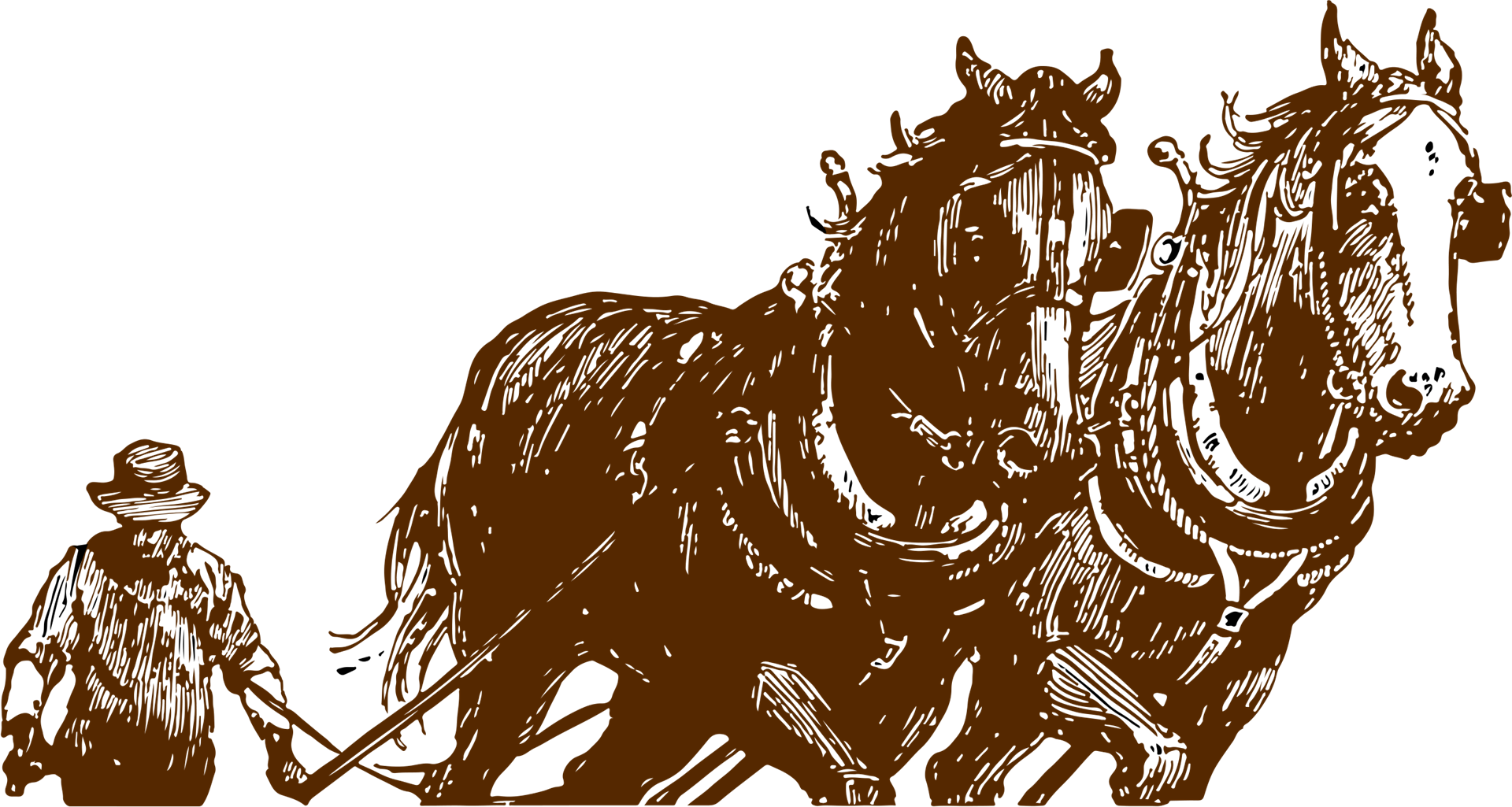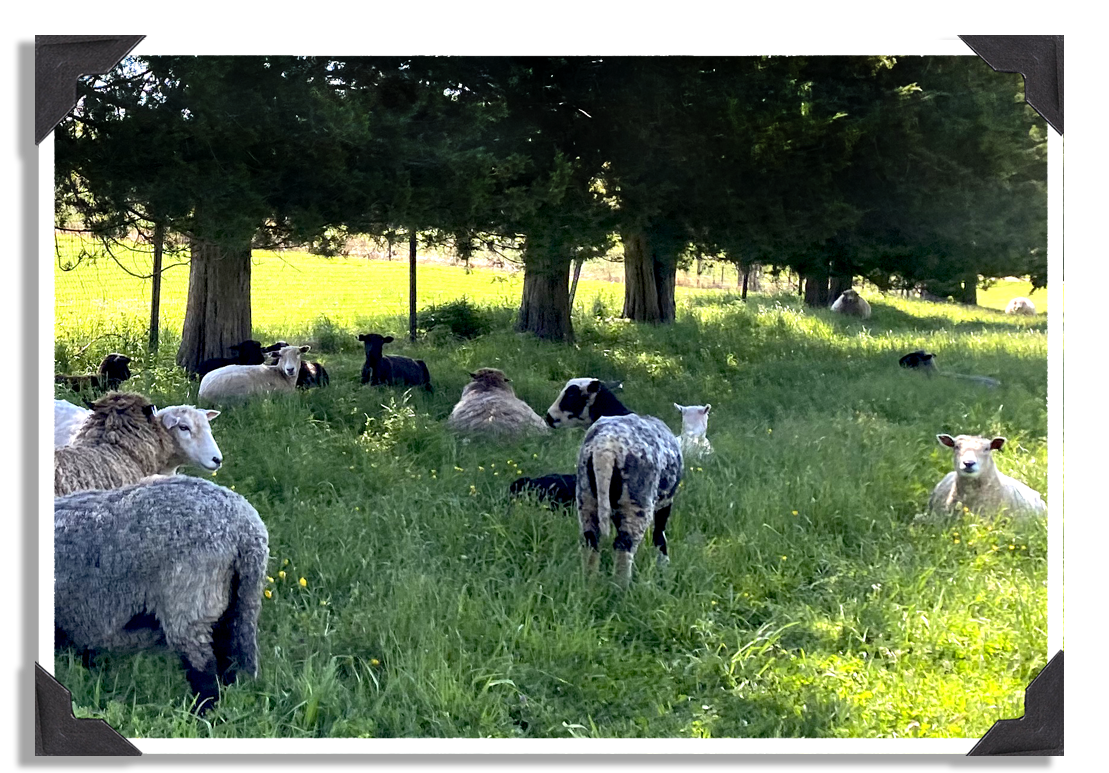Share the Harvest Farmers' Field Journal |
Above, Farmer Ian uses a McCormick reaper-binder pulled by Bill, Jesse, and Jeb to cut and bundle the remaining wheat. This year's crop was damaged by wind and rain, but there were enough sheaves to build a few shocks.
|
Once the season begins, string beans are harvested once every few days. On Friday 7/17, farmers picked 19 pounds to be donated to a Ewing food bank...along with 53 bunches of collards, 113 pounds of potatoes, 102 pounds of cabbage, 6 pounds of cucumbers, and 2 pounds of peppers! |
The first work done in the Market Garden was plowing under a crop of "green manure" – clover that was planted to fix nitrogen and other nutrients in the soil. Farmers attached a special "weed chain" to the front of the plow—which drags behind and lays down the tall clover grass on its side to be fully buried in each furrow. | Farmer Rob explains 'stale seedbedding' in front of the spring-tooth harrow he's been using to prepare the soil in the Market Garden |
Making Hay – Thursday, May 20 The season has officially begun, and last week farmers were hard at work making 200 bales from a field cut earlier with a tractor-drawn mower. Hay needs time to dry on the ground before it’s baled – and though the air is still chilly at times, a long streak of clear skies and windy days has made for a great first cut. Once mown, hay is raked into windrows to dry – then collected, baled, and stacked on wagons. If the bales are damp, the entire wagonload is parked under a roof or in a well-aerated building to dry further...because stacking wet hay in the barn is dangerous. Moisture trapped inside damp bales can begin to decompose and generate enough heat to start a fire!
Once the hay has cured, the baler is hooked to a wagon and pulled over the windrows with one farmer driving the tractor and 2 or 3 more stacking on the wagon. Depending on the moisture content, each 100-bale load is either pulled to the barnyard to be elevated into the loft directly–or parked in the equipment barn and allowed to air dry for a few days to prevent a buildup of heat at the center of the stack. The same process is used to bale straw for animal bedding, including the rye growing in the upper fields (right). Once wheat, rye, or oats have been harvested with a combine, the stalks left on the ground are raked and baled for use in horse stalls, chicken coops, and sheep barns. |
When the weather is hot and breezy, farmers cut the fields of timothy and orchard grass with a tractor-drawn mower, then use a mechanized rake to arrange the loose hay into windrows to dry for several hours in the sun before it's baled (above).
|
The last row of popcorn before Farmer Ian stops to empty the hoppers and switch to Indian corn | Planting Corn – Wednesday, May 19 Today farmer Ian again harnessed Tom and Jeb, this time to plant a 3-acre field with four varieties of corn: 4 rows of sweet corn, 8 of popcorn, 8 of Indian corn, and 44 of yellow dent field corn (for grinding into cornmeal or animal feed). Sweet corn rows are planted in halves – with the second planted in two weeks – to create a longer harvest even with a limited shelf life. The corn planter cuts two slices in the dirt and deposits seed from the cans on either side – with adjustments for different types of seed, planting depth, and rate at which kernels are dropped into the open rows. On both sides is a long metal rod that drags a line in the soil as a guide for the next pass; the farmer steers the horses to straddle the line for evenly-spaced rows. |
Fencing in the Potato Field – Friday, May 15 The last of the potatoes were planted by hand on and will be harvested in August to be donated to area food pantries. At the turn of the century, the deer population was just a fraction of what it is today, and farmers didn’t worry as much about fencing in crops. Today it’s a different story, and as the potato plants were just beginning to sprout, farmers were already hard at work building a temporary fence that will keep this year’s crop safe from wildlife.
Hauling Last Year's Crops – Tuesday, May 12 Today farmers emptied 40-pound bags of last year’s oats into the dump truck for transport to a mill in Lancaster county. Most of the oats used at Howell Farm become feed for the horses – but this year 4730 pounds of surplus oats will be dehusked and sent through a roller to make breakfast- and cookie-ready rolled oats for donation to local food banks.
| Weeding Potatoes – Sunday, May 17 Potatoes, like oats, get a boost from a few passes with the weeder early after they’ve started sprouting. Because Tom and Jeb’s harnesses have been in the shop for cleaning and repairs, this is their first work of the season. (Farmers like to start each team with some light work after their long winter vacation, and pulling the weeder is the perfect warm-up.) The machine itself amounts to a row of tines: disrupting the soil where small weeds are beginning to sprout among the potato plants – which are already hardy and well-rooted enough to withstand the tines. Farmers make two passes by overlapping half of each row with the next pass – always moving in the same direction and walking the horses between the rows. Harrowing the Cornfield – Thursday, May 14 The last step in preparing a field for planting is harrowing – a process by which the large clods of dirt left after plowing are broken up for a finer soil consistency. This year, farmer Ian is using a 1940s Farmall “H” tractor to pull the disc harrow over the field that was plowed last week with horses. On the last day of harrowing it's important to steer widthwise, in the opposite direction of planting, because in dry soil conditions it would be almost impossible to see the guide line struck after each pass with the corn planter. Mowing the Horse Pasture – Wednesday, May 13 Over the last few weeks Tom, Jeb, Bill, Jesse, Peter, Paul, and Chester have been grazing in the lower half of their night pasture...turning it into what looks like a freshly-mown putting green. Today farmers used a flail mower to cut overgrown patches of the upper section to make it more appealing to hungry horses, and tonight all 7 will walk up the path to find the first gate closed and the second open to a new dining area even better than the last. Weeding the Oats – Sunday, May 3 Using a special machine designed to lightly scrape the surface of the ground, Howell Farm horses Peter and Paul are weeding the oat field, upsetting tiny weed sprouts without damaging the well-rooted oat plants. This work is performed several times per season—ideally on hot, sunny days when the tiny upended weeds are scorched before they can reestablish their roots—until the oats grow high enough that little weeds don't stand a chance! |
Shearing the Last Sheep – Wednesday, May 13 It’s the second-to-last day of shearing, and farmers Evan and Margaret are working on two of the last few sheep. Even late in the season they keep their shearing blades razor-sharp, sharpening more or less depending on the type of wool and what kind of debris the sheep pick up from the ground. Farmer Margaret shears 150 sheep per year, and says that at farms in south Jersey, you can hear the sound of sand in your shears! |
|
A Fleece's Journey During the months of April and May, farmers will shear the farm's 24 adult sheep, and care for this year's 5 new lambs. Spring is the time to shear because the small amount of new wool that grows in the summer will actually insulate the sheep from heat. Though the farm remains closed to the public, the annual work of harvesting and processing the wool is underway, with several fleeces already sent to a mill to be spun into skeins of yarn. This year, members of the Pleasant Valley Stitchers' Guild will knit the wool into mittens, hats, scarves, and socks to be distributed at local community centers next winter.
|
















